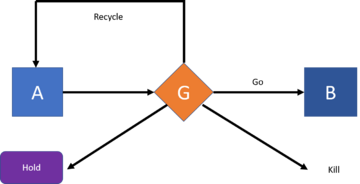Stage-Gate Process
Contents |
Abstract
The Stage-Gate Process (also referred to as Phase-Gate Process) is a project management tool, dividing the time horizon of a project into several information-gathering stages. These stages are separated by so-called gates, which represent go/kill/recycle decisions for the project. The concept was introduced by Cooper (1986) in his book 'Winning At New Products'[1].
The central background of the Stage-Gate Process is rooted in the fact that companies have limited resources (e.g. time, money & capital goods). To make effective use of the available resources and to manage risks, a firm has to develop its project portfolio in a manner that only the most promising/beneficial projects are put through. Regular Stage-Gate Processes include 4 to 8 stages, which can be conducted in parallel or can be skipped depending on the preferences of the company [2][3]. The evaluation criteria at each gate are discussed upfront with the project group and are acted upon by the gatekeeper during a gate meeting. Each gate decision should be a objective process; anybody in the organization should come to the same conclusion.
A Stage-Gate Process is complementary to project evaluation methods that, for example, analyze resource availability, project-related risks or costs and benefits of the project. The method is also frequently used in combination with other project management tools, like Gantt Charts or Concurrent Engineering theory [4] The process can be used in most project-related contexts, but gained a lot attention in the field of new product development as a strategic pacing method [5]
Basic Elements of the Stage-Gate Process
The basic idea of a Stage-Gate Process is that the whole project is divided in a predetermined set of stages. These stages consist of groups of related activities that end in so-called gates. Gates are characterized as containing a set of deliverables or inputs, a set of criteria, and an output [6].
Stages
Stages often consist of activities that roughly follow the same trajectory, where first the data is collected, integrated and analysed[3].
Cooper (2008) mentions several key characteristics that need to be taken into account when identifying stages[7]:
1. Each stage should strive to reduce key project uncertainties and risks. For the stage information requirements guide the team in their way-of-working.
2. Each stage is more costly than the preceding one, but risks and uncertainties are lower.
3. Activities within stages are undertaken in parallel and by a team of people from different backgrounds
4. Each stage is cross-functional; so no departmental focuses are present
Gates
Where stages represent a longer period of time (weeks or months); gates represent meetings with a time-span of several hours. At each gate the following elements are relevant to keep in mind [6]:
Inputs/Deliverables: the deliverables that the project leader must bring to the gate
Criteria: which are the items upon the input will be judged.
Outputs: the decisions at the gate, and possible the approval of an action plan for the next stage
Senior managers man the gates, and act as so-called gatekeepers. This group is diverse in nature and each member has the power to approve the resources needed for continuation of the project [6].
During the gate meeting the gatekeepers meet to discuss the future of a project. The objective decision they make is fully based at the ability of the team to meet the gate criteria. The following outputs can be generated during the gate meeting:
1. Go: proceed with the next stage
2. Kill: terminate the project
3. Recycle: restart the current stage, and optimize the results
4. Hold: delay the decision, and base the future output on resource availability
Application areas for the Stage-Gate Process
Possible theoretical synergies
Limitations of Using the Stage-Gate Process
References
- ↑ Cooper, R.G. (1986). Winning At New Products. Addison-Wesley, ISBN 0201136651
- ↑ O'Connor, P. (1994). From Experience; Implementing Stage-Gate Process: A Multi-Company Perspective. Journal of Product innovation Management. Vol 11. pp 183-200
- ↑ 3.0 3.1 Cooper, R.G. (2008). Perspective: The Stage-Gate Idea-to-Launch Process — Update What’s New, and NexGen Systems, Product Development & Management Association, Journal of Product Innovation Management. Vol. 25. pp 213–232
- ↑ Thamhain, H. (1996). Applying stage-gate processes in concurrent engineering. Wescon/96. pp 2-7
- ↑ Sharma, A. (1999). Central Dilemmas In Managing Innovation in Large Firms. California Management Review. Vol 41. No 3. pp 146-164
- ↑ 6.0 6.1 6.2 Cooper, R.G. (1990). Stage-Gate Systems: A New Tool for Managing New Products. Business Horizons. pp 44-54
- ↑ Cooper, R.G. (2008b). Perspective: The Stage-Gate Idea-to-Launch Process — Update What’s New, and NexGen Systems, Product Development & Management Association, Journal of Product Innovation Management. Vol. 25. pp 215
